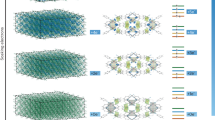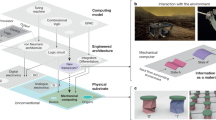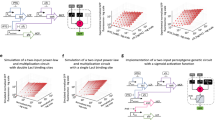Abstract
Molecular substrates can be viewed as computational devices that process physical or chemical 'inputs' to generate 'outputs' based on a set of logical operators. By recognizing this conceptual crossover between chemistry and computation, it can be argued that the success of life itself is founded on a much longer-term revolution in information handling when compared with the modern semiconductor computing industry. Many of the simpler logic operations can be identified within chemical reactions and phenomena, as well as being produced in specifically designed systems. Some degree of integration can also be arranged, leading, in some instances, to arithmetic processing. These molecular logic systems can also lend themselves to convenient reconfiguring. Their clearest application area is in the life sciences, where their small size is a distinct advantage over conventional semiconductor counterparts. Molecular logic designs aid chemical (especially intracellular) sensing, small object recognition and intelligent diagnostics.
This is a preview of subscription content, access via your institution
Access options
Subscribe to this journal
Receive 12 print issues and online access
$259.00 per year
only $21.58 per issue
Buy this article
- Purchase on Springer Link
- Instant access to full article PDF
Prices may be subject to local taxes which are calculated during checkout









Similar content being viewed by others
References
Raymo, F. M. Digital processing and communication with molecular switches. Adv. Mater. 14, 401–414 (2002).
Margulies, D. Felder, C. E., Melman, G. & Shanzer, A. A molecular keypad lock: a photochemical device capable of authorizing password entries. J. Am. Chem. Soc. 129, 347–354 (2007).
Boole, G. An Investigation of the Laws of Thought (Dover, New York, 1958).
Malvino, A. P. & Brown, J. A. Digital Computer Electronics 3rd edn (Glencoe, New York, 1993).
Bray, D. Protein molecules as computational elements in living cells. Nature 376, 307–312 (1995).
Williams, K. A. Three-dimensional structure of the ion-coupled transport protein NhaA. Nature 403, 112–115 (2000).
Lehn, J.-M. Supramolecular Chemistry (VCH, Weinheim, 1995).
Collier, C. P. et al. Electronically configurable molecular-based logic gates. Science 285, 391–394 (1999).
Amir, R. J., Popkov, M., Lerner, R. A., Barbas III, C. F. & Shabat, D. Prodrug activation gated by a molecular “OR” logic trigger. Angew. Chem. Int. Edn 44, 4378–4381 (2005).
Grynkiewicz, G., Poenie, M. & Tsien, R. Y. A new generation of Ca2+ indicators with greatly improved fluorescence properties. J. Biol. Chem. 260, 3440–3450 (1985).
Holman, M. W. & Adams, D. M. Using single-molecule fluorescence spectroscopy to study electron transfer. ChemPhysChem 5, 1831–1836 (2004).
Uchiyama, S., McClean, G. D., Iwai, K. & de Silva, A. P. Membrane media create small nanospaces for molecular computation. J. Am. Chem. Soc. 127, 8920–8921 (2005).
Drexler, K. E. Engines of Creation (Anchor Press, New York, 1986).
de Silva, A. P., Gunaratne, H. Q. N. & McCoy, C. P. A molecular photoionic AND gate based on fluorescent signalling. Nature 364, 42–44 (1993).
Bissell, R. A. et al. Fluorescent PET (photoinduced electron transfer) sensors. Top. Curr. Chem. 168, 223–264 (1993).
Komura, T., Niu, G. Y., Yamaguchi, T. & Asano, M. Redox and ionic-binding switched fluorescence of phenosafranine and thionine included in Nafion® films. Electrochim. Acta 48, 631–639 (2003).
Szaciłowski, K., Macyk, W. & Stochel, G. Light-driven OR and XOR programmable chemical logic gates. J. Am. Chem. Soc. 128, 4550–4551 (2006).
Biancardo, M., Bignozzi, C., Doyle, H. & Redmond, G. A potential and ion switched molecular photonic logic gate. Chem. Commun. 3918–3920 (2005).
Matsui, J., Mitsuishi, M., Aoki, A. & Miyashita, T. Molecular optical gating devices based on polymer nanosheets assemblies. J. Am. Chem. Soc. 126, 3708–3709 (2004).
Yurke, B., Mills Jr., A. P. & Cheng, S. L. DNA implementation of addition in which the input strands are separate from the operator strands. Biosystems 52, 165–174 (1999).
Schneider, H.-J., Tianjun, L., Lomadze, N. & Palm, B. Cooperativity in a chemomechanical polymer: a chemically induced macroscopic logic gate. Adv. Mater. 16, 613–615 (2004).
Okamoto, A., Tanaka, K. & Saito, I. DNA logic gates. J. Am. Chem. Soc. 126, 9458–9463 (2004).
Ashkenasy, G. & Ghadiri, M. R. Boolean logic functions of a synthetic peptide network. J. Am. Chem. Soc. 126, 11140–11141 (2004).
Blittersdorf, R., Müller, J. & Schneider, F. W. Chemical visualization of Boolean functions: a simple chemical computer. J. Chem. Educ. 72, 760–763 (1995).
Raymo, F. M. & Giordani, S. All-optical processing with molecular switches. Proc. Natl. Acad. Sci. USA 99, 4941–4944 (2002).
Szaciłowski, K. Molecular logic gates based on pentacyanoferrate complexes: from simple gates to three-dimensional logic systems. Chem. Eur. J. 10, 2520–2528 (2004).
de Silva, A. P. et al. Signaling recognition events with fluorescent sensors and switches. Chem. Rev. 97, 1515–1566 (1997).
Balzani, V., Credi, A. & Venturi, M. Molecular Devices and Machines (Wiley-VCH, Weinheim, 2003).
de Silva, A. P. & McClenaghan, N. D. Molecular-scale logic gates. Chem. Eur. J. 10, 574–586 (2004).
de Silva, A. P. & McClenaghan, N. D. Simultaneously multiply-configurable or superposed molecular logic systems composed of ICT (internal charge transfer) chromophores and fluorophores integrated with one- or two-ion receptors. Chem. Eur. J. 8, 4935–4945 (2002).
de Silva, A. P. & McClenaghan, N. D. Proof-of-principle of molecular-scale arithmetic. J. Am. Chem. Soc. 122, 3965–3966 (2000).
Zhou, Y., Zhang, D., Zhang, Y., Tang, Y. & Zhu, D. Tuning the CD spectrum and optical rotation value of a new binaphthalene molecule with two spiropyran units: mimicking the function of a molecular “AND” logic gate and a new chiral molecular switch. J. Org. Chem. 70, 6164–6170 (2005).
Tamaki, T. & Ichimura, K. Photochromic chelating spironaphthoxazines. J. Chem. Soc., Chem. Commun. 1477–1479 (1989).
Gobbi, L., Seiler, P. & Diederich, F. A novel three-way chromophoric molecular switch: pH and light controllable switching cycles. Angew. Chem. Int. Edn 38, 674–678 (1999).
Wojtyk, J. T. C., Kazmaier, P. M. & Buncel, E. Effects of metal ion complexation on the spiropyran–merocyanine interconversion: development of a thermally stable photo-switch. Chem. Commun. 1703–1704 (1998).
Raymo, F. M. & Giordani, S. Multichannel digital transmission in an optical network of communicating molecules. J. Am. Chem. Soc. 124, 2004–2007 (2002).
Baron, R., Lioubashevski, O., Katz, E., Niazov, T. & Willner, I. Two coupled enzymes perform in parallel the 'AND' and 'InhibAND' logic gate operations. Org. Biomol. Chem. 4, 989–991 (2006).
Baron, R., Lioubashevski, O., Katz, E., Niazov, T. & Willner, I. Elementary arithmetic operations by enzymes: a model for metabolic pathway based computing. Angew. Chem. Int. Edn 45, 1572–1576 (2006).
Zauner, K.-P. & Conrad, M. Enzymatic Computing. Biotechnol. Prog. 17, 553–559 (2001).
Deonarine, A. S., Clark, S. M. & Konermann, L. Implementation of a multifunctional logic gate based on folding/unfolding transitions of a protein. Future Gener. Comp. Sy. 19, 87–97 (2003).
Sivan, S., Tuchman, S. & Lotan, N. A biochemical logic gate using an enzyme and its inhibitor. Part II: The logic gate. BioSystems 70, 21–33 (2003).
Adleman, L. M. Molecular computation of solutions to combinatorial problems. Science 266, 1021–1024 (1994).
Stojanovic, M. N., Mitchell, T. E. & Stefanovic, D. Deoxyribozyme-based logic gates. J. Am. Chem. Soc. 124, 3555–3561 (2002).
Hod, O., Baer, R. & Rabani, E. A parallel electromagnetic molecular logic gate. J. Am. Chem. Soc. 127, 1648–1649 (2005).
Tour, J. M. in Stimulating Concepts in Chemistry (eds. Vögtle, F. Stoddart, J. F. & Shibasaki, M.) 237–253 (Wiley-VCH, Weinheim, 2000).
Kele, P., Orbulescu, J., Gawley, R. E. & Leblanc, R. M. Spectroscopic detection of saxitoxin: An alternative to mouse bioassay. Chem. Commun. 1494–1496 (2006).
Hall, M. J., Allen, L. T. & O'Shea, D. F. PET modulated fluorescent sensing from the BF2 chelated azadipyrromethene platform. Org. Biomol. Chem. 4, 776–780 (2006).
Kwon, J. Y. et al. A highly selective fluorescent chemosensor for Pb2+. J. Am. Chem. Soc. 127, 10107–10111 (2005).
Yoon, S., Albers, A. E., Wong, A. P. & Chang, C. J. Screening mercury levels in fish with a selective fluorescent chemosensor. J. Am. Chem. Soc. 127, 16030–16031 (2005).
Banthia, S. & Samanta, A. A two-dimensional chromogenic sensor as well as fluorescence inverter: selective detection of copper(II) in aqueous medium. New J. Chem. 29, 1007–1010 (2005).
Dale, T. J. & Rebek Jr., J. Fluorescent sensors for organophosphorus nerve agent mimics. J. Am. Chem. Soc. 128, 4500–4501 (2006).
Bencic-Nagale, S., Sternfeld, T. & Walt, D. R. Microbead chemical switches: An approach to detection of reactive organophosphate chemical warfare agent vapors. J. Am. Chem. Soc. 128, 5041–5048 (2006).
de Silva, A. P., Gunaratne, H. Q. N. & Gunnlaugsson, T. Fluorescent PET (photoinduced electron transfer) reagents for thiols. Tetrahedron Lett. 39, 5077–5080 (1998).
Cooper, C. R. & James, T. D. Selective D-glucosamine hydrochloride fluorescence signalling based on ammonium cation and diol recognition. Chem. Commun. 1419–1420 (1997).
Fages, F. et al. Synthesis and fluorescence emission properties of a bis-anthracenyl macrotricyclic ditopic receptor. Crystal structure of its dinuclear rubidium cryptate. J. Chem. Soc., Chem. Commun. 655–658 (1990).
de Silva, A. P. & Sandanayake, K. R. A. S. Fluorescence “off-on” signalling upon linear recognition and binding of α,ω-alkanediyldiammonium ions by 9,10-bis{(1-aza-4,7,10,13,16-pentaoxacyclooctadecyl)methyl}anthracene. Angew. Chem. Int. Edn Engl. 29, 1173–1175 (1990).
Misumi, S. Recognitory coloration of cations with chromoacerands. Top. Curr. Chem. 165, 163–192 (1993).
Secor, K., Plante, J., Avetta, C. & Glass, T. Fluorescent sensors for diamines. J. Mater. Chem. 15, 4073–4077 (2005).
Zhao, J., Fyles, T. M. & James, T. D. Chiral binol-bisboronic acid as fluorescence sensor for sugar acids. Angew. Chem. Int. Edn 43, 3461–3464 (2004).
James, T. D., Sandanayake, K. R. A. S. & Shinkai, S. Chiral discrimination of monosaccharides using a fluorescent molecular sensor. Nature 374, 345–347 (1995).
Gray Jr., C. W. & Houston, T. A. Boronic acid receptors for α-hydroxycarboxylates: high affinity of Shinkai's glucose receptor for tartrate. J. Org. Chem. 67, 5426–5428 (2002).
He, J. X. et al. Metal-free silicon-molecule-nanotube testbed and memory device. Nature Mater. 5, 63–68 (2006).
de Silva, A. P. et al. Integration of logic functions and sequential operation of gates at the molecular-scale. J. Am. Chem. Soc. 121, 1393–1394 (1999).
Mu, L. X., Wang, Y., Zhang, Z. & Jin, W. J. Room temperature phosphorescence pH switch based on photo-induced electron transfer. Chinese Chem. Lett. 15, 1131–1134 (2004).
de Sousa, M., de Castro, B., Abad, S., Miranda, M. A. & Pischel, U. A molecular tool kit for the variable design of logic operations (NOR, INH, EnNOR). Chem. Commun. 2051–2053 (2006).
Cheng, P.-N., Chiang, P.-T. & Chiu, S.-H. A switchable macrocycle-clip complex that functions as a NOR logic gate. Chem. Commun. 1285–1287 (2005).
Giordani, S., Cejas, M. A. & Raymo, F. M. Photoinduced proton exchange between molecular switches. Tetrahedron 60, 10973–10981 (2004).
Margulies, D., Melman, G. & Shanzer, A. Fluorescein as a model molecular calculator with reset capability. Nature Mater. 4, 768–771 (2005).
Shiraishi, Y., Tokitoh, Y. & Hirai, T. A fluorescent molecular logic gate with multiply-configurable dual outputs. Chem. Commun. 5316–5318 (2005).
Alves, S. et. al. Open-chain polyamine ligands bearing an anthracene unit–chemosensors for logic operations at the molecular level. Eur. J. Inorg. Chem. 405–412 (2001).
Callan, J. F., de Silva, A. P. & McClenaghan, N. D. Switching between molecular switch types by module rearrangement: Ca2+-enabled, H+-driven 'off-on-off', H+-driven YES and PASS 0 as well as H+, Ca2+-driven AND logic operations. Chem. Commun. 2048–2049 (2004).
Qu, D.-H., Wang, Q.-C. & Tian, H. A half adder based on a photochemically driven [2]rotaxane. Angew. Chem. Int. Edn 44, 5296–5299 (2005).
Andréasson, J. et al. Molecule-based photonically switched half-adder. J. Am. Chem. Soc. 126, 15926–15927 (2004).
Lederman, H., Macdonald, J., Stefanovic, D. & Stojanovic, M. N. Deoxyribozyme-based three-input logic gates and construction of a molecular full adder. Biochemistry 45, 1194–1199 (2006).
Guo, X., Zhang, D., Zhang, G. & Zhu, D. Monomolecular logic: “half-adder” based on multistate/multifunctional photochromic spiropyrans. J. Phys. Chem. B 108, 11942–11945 (2004).
Stojanovic, M. N. & Stefanovic, D. A deoxyribozyme-based molecular automaton. Nature Biotechnol. 21, 1069–1074 (2003).
Wild, U. P., Bernet, S., Kohler, B. & Renn, A. From supramolecular photochemistry to the molecular computer. Pure Appl. Chem. 64, 1335–1342 (1992).
Margulies, D., Melman, G. & Shanzer, A. A molecular full-adder and full-subtractor, an additional step toward a moleculator. J. Am. Chem. Soc. 128, 4865–4871 (2006).
Tour, J. M. Molecular electronics. Synthesis and testing of components. Acc. Chem. Res. 33, 791–804 (2000).
Williams, R. S., quoted in Ball, P. Chemistry meets computing. Nature 406, 118–120 (2000).
Cox, J. C., Cohen, D. S. & Ellington, A. D. The complexities of DNA computation. Trends Biotechnol. 17, 151–154 (1999).
Lam, K. S. et al. A new type of synthetic peptide library for identifying ligand-binding activity. Nature 354, 82–84 (1991).
Furka, Á., Sebestyén, F., Asgedom, M. & Dibó, G. General-method for rapid synthesis of multicomponent peptide mixtures. Int. J. Pept. Prot. Res. 37, 487–493 (1991).
Shepard, S. RFID: Radio Frequency Identification (McGraw-Hill, New York, 2005).
Nicolaou, K. C., Xiao, X.-Y., Parandoosh, Z., Senyei, A. & Nova, M. P. Radiofrequency encoded combinatorial chemistry. Angew. Chem. Int. Edn Engl. 34, 2289–2291 (1995).
Moran, E. J. et al. Radio frequency tag encoded combinatorial library method for discovery of tripeptide-substituted cinnamic acid inhibitors of the protein tyrosine phosphatase PTP1B. J. Am. Chem. Soc. 117, 10787–10788 (1995).
Walt, D. R. Bead-based fiber-optic arrays. Science 287, 451–452 (2000).
Battersby, B. J., Lawrie, G. A., Johnston, A. P. R. & Trau, M. Optical barcoding of colloidal suspensions: applications in genomics, proteomics and drug discovery. Chem. Commun. 1435–1441 (2002).
de Silva, A. P., James, M. R., McKinney, B. O. F., Pears, P. A. & Weir, S. M. Molecular computational elements encode large populations of small objects. Nature Mater. 5, 787–790 (2006).
Hayes, B. Third base. Am. Scientist 89, 490–494 (2001).
Callan, J. F., de Silva, A. P., Ferguson, J., Huxley, A. J. M. & O'Brien, A. M. Fluorescent photoionic devices with two receptors and two switching mechanisms: applications to pH sensors and implications for metal ion detection. Tetrahedron 60, 11125–11131 (2004).
Magri, D. C., Brown, G. J., McClean, G. D. & de Silva, A. P. Communicating chemical congregation: a molecular AND logic gate with three chemical inputs as a “lab-on-a-molecule” prototype. J. Am. Chem. Soc. 128, 4950–4951 (2006).
Gunnlaugsson, T., Lee, T. C. & Parkesh, R. A highly selective and sensitive fluorescent PET (photoinduced electron transfer) chemosensor for Zn(II). Org. Biomol. Chem. 1, 3265–3267 (2003).
Lankshear, M. D., Cowley, A. R. & Beer, P. D. Cooperative AND receptor for ion-pairs. Chem. Commun. 612–614 (2006).
Koskela, S. J. M., Fyles, T. M. & James, T. D. A ditopic fluorescent sensor for potassium fluoride. Chem. Commun. 945–947 (2005).
Saghatelian, A., Völcker, N. H., Guckian, K. M., Lin, V. S.-Y. & Ghadiri, M. R. DNA-based photonic logic gates: AND, NAND, and INHIBIT. J. Am. Chem. Soc. 125, 346–347 (2003).
Gust, D., Moore, T. A. & Moore, A. L. Molecular switches controlled by light. Chem. Commun. 1169–1178 (2006).
Pina, F. et al. Multistate/multifunctional molecular-level systems: light and pH switching between the various forms of a synthetic flavylium salt. Chem. Eur. J. 4, 1184–1191 (1998).
Uchiyama, S., Kawai, N., de Silva, A. P. & Iwai, K. Fluorescent polymeric AND logic gate with temperature and pH as inputs. J. Am. Chem. Soc. 126, 3032–3033 (2004).
Leigh, D. A. et al. Patterning through controlled submolecular motion: rotaxane-based switches and logic gates that function in solution and polymer films. Angew. Chem. Int. Edn 44, 3062–3067 (2005).
Penchovsky, R. & Breaker, R. R. Computational design and experimental validation of oligonucleotide-sensing allosteric ribozymes. Nature Biotechnol. 23, 1424–1433 (2005).
Remacle, F., Speiser, S. & Levine, R. D. Intermolecular and intramolecular logic gates. J. Phys. Chem. B 105, 5589–5591 (2001).
Remacle, F., Weinkauf, R. & Levine, R. D. Molecule-based photonically switched half and full adder. J. Phys. Chem. A 110, 177–184 (2006).
Acknowledgements
We are grateful for support from Avecia, The Daiwa Anglo-Japanese Foundation, DEL, EPSRC, Invest NI (RTD COE 40), Japan Society for the Promotion of Science and Procter and Gamble. This paper is dedicated to Fraser Stoddart.
Author information
Authors and Affiliations
Rights and permissions
About this article
Cite this article
de Silva, A., Uchiyama, S. Molecular logic and computing. Nature Nanotech 2, 399–410 (2007). https://doi.org/10.1038/nnano.2007.188
Issue Date:
DOI: https://doi.org/10.1038/nnano.2007.188
This article is cited by
-
Engineering DNA logic systems with non-canonical DNA-nanostructures: basic principles, recent developments and bio-applications
Science China Chemistry (2022)
-
A binuclear ruthenium polypyridyl complex: synthesis, characterization, pH luminescence sensor and electrochemical properties
Transition Metal Chemistry (2021)
-
“Plug and Play” logic gate construction based on chemically triggered fluorescence switching of gold nanoparticles conjugated with Cy3-tagged aptamer
Microchimica Acta (2020)
-
Molecular memory with downstream logic processing exemplified by switchable and self-indicating guest capture and release
Nature Communications (2019)



